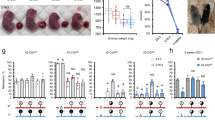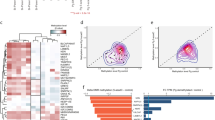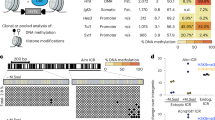Abstract
Genomic imprinting causes parental origin–specific gene expression1. Cis-acting regulatory elements that control imprinting are not fully understood but involve regions that become differentially methylated on the two parental chromosomes during male and female gametogenesis2,3,4. Understanding properties of maternally and paternally inherited imprints provides insight into the mechanisms and evolution of genomic imprinting. Previously we identified an intergenic germline-derived differentially methylated region (IG-DMR) that is a candidate control element for an imprinted domain on distal mouse chromosome 12 (ref. 5). The 1-Mb cluster contains the paternally expressed protein-coding genes Dlk1 (refs. 6,7) and Dio3 (ref. 8,9) and several maternally expressed non-coding RNAs, including Gtl2 (refs. 6,7,10) and C/D snoRNAs11. A retrotransposon-like gene (Rtl1) is expressed from the paternal chromosome and has an antisense transcript expressed from the maternal chromosome containing two microRNAs with full complementarity to Rtl1 (ref. 12). Here we show that deletion of the IG-DMR from the maternally inherited chromosome causes bidirectional loss of imprinting of all genes in the cluster. When the deletion is transmitted from the father, imprinting is unaltered. These results prove that the IG-DMR is a control element for all imprinted genes on the maternal chromosome only and indicate that the two parental chromosomes control allele-specific gene expression differently.
This is a preview of subscription content, access via your institution
Access options
Subscribe to this journal
Receive 12 print issues and online access
$209.00 per year
only $17.42 per issue
Buy this article
- Purchase on Springer Link
- Instant access to full article PDF
Prices may be subject to local taxes which are calculated during checkout






Similar content being viewed by others
Accession codes
References
Ferguson-Smith, A.C. & Surani, M.A. Imprinting and the epigenetic asymmetry between parental genomes. Science 293, 1086–1089 (2001).
Bird, A. DNA methylation patterns and epigenetic memory. Genes. Dev. 16, 6–21 (2002).
Bourc'his, D., Xu, G.L., Lin C.S., Bollman, B. & Bestor, T.H. Dnmt3L and the establishment of maternal genomic imprints. Science 294, 2536–2539 (2001).
Hata, K., Okano, M., Lei, H. & Li, E. Dnmt3L cooperates with the Dnmt3 family of de novo DNA methyltransferases to establish maternal imprints in mice. Development 129, 1983–1893 (2002).
Takada, S. et al. Epigenetic analysis of the Dlk1-Gtl2 imprinted domain on mouse chromosome 12: implications for imprinting control from comparison with Igf2-H19. Hum. Mol. Genet. 11, 77–86 (2002).
Takada, S. et al. Delta-like and Gtl2 are reciprocally expressed, differentially methylated linked imprinted genes on mouse chromosome 12. Curr. Biol. 10, 1135–1138 (2000).
Schmidt, J.V., Matteson, P.G., Jones, B.K., Guan, X.J. & Tilghman, S.M. The Dlk1 and Gtl2 genes are linked and reciprocally imprinted. Genes Dev. 14, 1997–2002 (2000).
Tsai, C.-E. et al. Genomic imprinting contributes to thyroid hormone metabolism in the mouse embryo. Curr. Biol. 12, 1221–1226 (2002).
Yevtodiyenko, A., Carr, M.S., Patel N. & Schmidt, J. Analysis of candidate imprinted genes linked to Dlk1-Gtl2 using a congenic mouse line. Mamm. Genome 13, 633–638 (2002).
Miyoshi, N. et al. Identification of an imprinted gene, Meg3/Gtl2 and its human homologue MEG3, first mapped on mouse distal chromosome 12 and human chromosome 14q. Genes Cells 5, 211–220 (2000).
Cavaille, J., Seitz, H., Paulsen, M., Ferguson-Smith, A.C. & Bachellerie, J.P. Identification of tandemly-repeated C/D snoRNA genes at the imprinted human 14q32 domain reminiscent of those at the Prader-Willi/Angelman syndrome region. Hum. Mol. Genet. 11, 1527–1538 (2002).
Seitz, H. et al. Imprinted microRNA genes transcribed antisense to a reciprocally imprinted retrotransposon-like gene. Nat. Genet. 34, 261–262 (2003)
Paulsen, M. et al. Comparative sequence analysis of the imprinted Dlk1-Gtl2 locus in three mammalian species reveals highly conserved genomic elements and refines comparison with the Igf2-H19 region. Genome Res. 11, 2085–2094 (2001).
Georgiades, P., Watkins, M., Surani, M.A. & Ferguson-Smith, A.C. Parental origin-specific developmental defects in mice with uniparental disomy for chromosome 12. Development. 127, 4719–4728 (2000).
Georges, M., Charlier, C. & Cockett, N. The callipyge locus: evidence for the trans interaction of reciprocally imprinted genes. Trends Genet. 19, 248–252 (2003).
Charlier, C. et al. The callipyge mutation enhances the expression of coregulated imprinted genes in cis without affecting their imprinting status. Nat. Genet. 27, 367–369 (2001).
Schuster-Gossler, K., Bilinski, P., Sado, T., Ferguson-Smith, A. & Gossler, A. The mouse Gtl2 gene is differentially expressed during embryonic development, encodes multiple alternatively spliced transcripts and may act as an RNA. Dev. Dyn. 212, 214–228 (1998).
Wylie, A.A., Murphy, S.K., Orton, T.C. & Jirtle, R.L. Novel imprinted DLK1/GTL2 domain on human chromosome 14 contains motifs that mimic those implicated in IGF2/H19 regulation. Genome Res. 10, 1711–1718 (2000).
Temple, I.K., Cockwell, A., Hassold, T., Pettay, D. & Jacobs, P. Maternal uniparental disomy for chromosome 14. J. Med. Genet. 28, 511–514 (1991).
Wang, J., Passage, M., Yen, P., Shapiro, L. & Mohandas, T. Uniparental heterodisomy for chromosome 14 in a phenotypically abnormal familial balanced 13/14 Robertsonian translocation carrier. Am. J. Hum. Genet. 48, 1069–1074 (1991).
Arney, K. H19 and Igf2—enhancing the confusion? Trends Genet. 19, 17–23 (2003).
Thorvaldsen, J.L., Duranm K.L. Bartolomei M.S. Deletion of the H19 differentially methylated domain results in loss of imprinted expression of H19 and Igf2. Genes Dev. 12, 3693–3702 (1998).
Buiting, K. et al. Epimutation in Prader-Willi and Angelman syndromes: a molecular study of 136 patients with an imprinting defect. Am. J. Hum. Genet. 72, 571–577 (2003).
Sleutels, F., Zwart, R. & Barlow, D. The non-coding Air RNA is required for silencing autosomal imprinted genes. Nature 415, 810–813 (2002).
Fitzpatrick, G., Soloway, P.D. & Higgins, M.J. Regional loss of imprinting and growth deficiency in mice with a targeted deletion of KvDMR1. Nat. Genet. 32, 426–431 (2002).
Mancini-DiNardo, D., Steele, S.J., Ingram, R.S. & Tilghman, S.M. A differentially methylated region within the gene Kcnq1 functions as an imprinted promoter and silencer. Hum. Mol. Genet. 12, 283–294 (2003).
Georgiades, P., Watkins, M., Burton, G.J. & Ferguson-Smith, A.C. Roles for genomic imprinting and the zygotic genome in placental development. Proc. Natl. Acad. Sci. USA 98, 4522–4527 (2001).
Constancia, M. et al. Deletion of a silencer element in Igf2 results in loss of imprinting independent of H19. Nat. Genet. 26, 203–206 (2000).
Mundt, C., Licence, S., Shimizu, T., Melchers, F. & Martensson, I.L. Loss of precursor B cell expansion but not allelic exclusion in VpreB1/VpreB2 double-deficient mice. J. Exp. Med. 193, 435–445 (2001).
Acknowledgements
We thank D. Barlow, G. Kelsey and members of the laboratory of A.C.F.-S. for discussions of this work; P.-W. Teng and A. Woodhouse for technical assistance; M. George and E. Saunders of the Babraham Gene Targeting Facility for ES cell culture and blastocyst injection; R. Voutilainen for assistance with the cell cultures; and M. Constancia for advice with the targeting construct. This work was supported by grants from the UK Medical Research Council and Cancer Research UK. S.-P.L. is funded by a graduate research scholarship from the Taiwanese Government, N.Y. by a BBSRC studentship and H.S. by a PhD fellowship from the Allocation de Moniteur Normalien.
Author information
Authors and Affiliations
Ethics declarations
Competing interests
The authors declare no competing financial interests.
Rights and permissions
About this article
Cite this article
Lin, SP., Youngson, N., Takada, S. et al. Asymmetric regulation of imprinting on the maternal and paternal chromosomes at the Dlk1-Gtl2 imprinted cluster on mouse chromosome 12. Nat Genet 35, 97–102 (2003). https://doi.org/10.1038/ng1233
Received:
Accepted:
Published:
Issue Date:
DOI: https://doi.org/10.1038/ng1233
This article is cited by
-
Maternal RNA transcription in Dlk1-Dio3 domain is critical for proper development of the mouse placental vasculature
Communications Biology (2024)
-
Epigenetic mechanism of Gtl2-miRNAs causes the primitive sheep characteristics found in purebred Merino sheep
Cell & Bioscience (2023)
-
Effects of paternal exposure to cigarette smoke on sperm DNA methylation and long-term metabolic syndrome in offspring
Epigenetics & Chromatin (2022)
-
From genotype to phenotype: genetics of mammalian long non-coding RNAs in vivo
Nature Reviews Genetics (2022)
-
Global miRNA/proteomic analyses identify miRNAs at 14q32 and 3p21, which contribute to features of chronic iron-exposed fallopian tube epithelial cells
Scientific Reports (2021)



